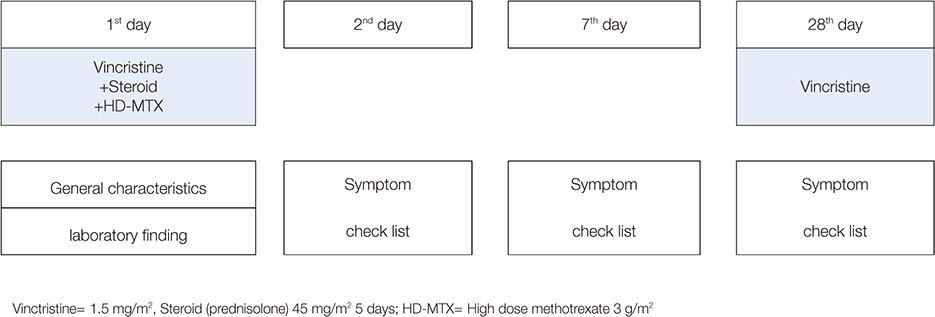Asian Oncol Nurs.
2016 Dec;16(4):169-175. 10.5388/aon.2016.16.4.169.
Physical, Psychological and Social Symptoms, Activity and Education of Children and Adolescents with Acute Lymphoblastic Leukemia Receiving Maintenance Chemotherapy
- Affiliations
-
- 1BMT Center, Seoul St. Mary's Hospital, The Catholic University of Korea, Seoul, Korea. bm.coor@catholic.ac.kr
- 2Department of Nursing, Mokpo National University, Muan, Korea.
- KMID: 2366571
- DOI: http://doi.org/10.5388/aon.2016.16.4.169
Abstract
- PURPOSE
This study was to identify the physical, psychological and social symptoms of ALL (acute lymphoblastic leukemia) children and adolescents receiving maintenance chemotherapy to build a basic data set to produce effective nursing intervention and ultimately help their early return to school and social adaptation.
METHODS
Fifty ALL children and adolescents between 4 and 18, who were receiving maintenance chemotherapy were surveyed on days 2, 7, and 28. For younger children, between the age of 4 and the 3rd year in elementary school, their primary caregivers answered the survey and those between the 4th year in elementary school and the age of 18 answered the survey themselves.
RESULTS
During maintenance chemotherapy, ALL children and adolescents experience diverse physical, psychological and social symptoms. On days 7 and 28, physical and social symptoms were greater than physical symptoms. Physical symptoms were greatest on day 2 and the most psychological and social symptoms were observed on day 7. During the maintenance chemotherapy period, 40% of the children and adolescents could not attend regular educational institutions.
CONCLUSION
Since each point in the maintenance chemotherapy period shows different symptomatic characteristics, nursing intervention can be provided appropriately for each specific point to help the patients' social adaptation and early return to school.
MeSH Terms
Figure
Reference
-
1. Jung KW, Won YJ, Kong HJ, Oh CM, Cho H, Lee DH, et al. Cancer statistics in Korea: incidence, mortality, survival, and prevalence in 2012. Cancer Res Treat. 2015; 47(2):127–141.
Article2. Ministry of health and welfare korea, national cancer center korea. Cancer facts & figures. Seoul: Ministry of health and welfare korea;2010.3. Park HJ, Park EH, Jung KW, Kong HJ, Won YJ, Lee JY, et al. Statistics of hematologic malignancies in Korea: incidence, prevalence and survival rates from 1999 to 2008. Korean J Hematol. 2012; 47(1):28–38.
Article4. Hendricks-Ferguson V. Relationships of age and gender to hope and spiritual well-being among adolescents with cancer. J Pediatr Oncol Nurs. 2006; 23(4):189–199.
Article5. Gurney JG, Krull KR, Kadan-Lottick N, Nicholson HS, Nathan PC, Zebrack B, et al. Social outcomes in the childhood cancer survivor study cohort. J Clin Oncol. 2009; 27(14):2390–2395.
Article6. Pui CH, Yang JJ, Hunger SP, Pieters R, Schrappe M, Biondi A, et al. Childhood acute lymphoblastic leukemia: progress through collaboration. J Clin Oncol. 2015; 33(27):2938–2948.
Article7. Kim GD, Kim KH. Symptom cluster and quality of life in patients with breast cancer undergoing chemotherapy. Korean J Adult Nurs. 2011; 23(5):434–445.8. Collins JJ, Devine TD, Dick GS, Johnson EA, Kilham HA, Pinkerton CR, et al. The measurement of symptoms in young children with cancer: the validation of the Memorial Symptom Assessment Scale in children aged 7-12. J Pain Symptom Manage. 2002; 23(1):10–16.9. Yeh CH, Chiang YC, Chien LC, Lin L, Yang CP, Chuang HL. Symptom clustering in older Taiwanese children with cancer. Oncol Nurs Forum. 2008; 35(2):273–281.
Article10. Lenz ER, Pugh LC, Milligan RA, Gift A, Suppe F. The middle-range theory of unpleasant symptoms: an update. ANS Adv Nurs Sci. 1997; 19(3):14–27.
Article11. Zelcer S, Kellick M, Wexler LH, Gorlick R, Meyers PA. The Memorial Sloan Kettering Cancer Center experience with outpatient administration of high dose methotrexate with leucovorin rescue. Pediatr Blood Cancer. 2008; 50(6):1176–1180.
Article12. Choi SH, Kim KS, Kim KE, Kim JW. Comparison of high dose methotrexate administration between the inpatient and outpatient setting in children with acute lymphoblastic leukemia. Asian Oncol Nurs. 2014; 14(2):93–99.
Article13. Kim Jy, Park Eh, Kim YR. The qualitative research on the current status of educational supports and an improvement plan for students with health impairments. Korean J Spec Educ. 2015; 50(1):57–77.
Article14. Nam SI, Choi KH. School reintegration, adjustment difficulties, and services for childhood cancer survivors. Korean J Soc Welf Res. 2013; 38:181–215.15. Kim SH. Identification of symptoms by treatment phases in children with leukemia [master's thesis]. Seoul: Yonsei Univ.;2009.16. Choi J. Development of a treatment stage based nursing intervention protocol for adolescents with cancer [dissertation]. Seoul: Yonsei Univ.;2000.17. The Catholic Medical Center Korea. 2013 CMC medical index. Seoul: The Catholic Medical Center;2013.18. Martha E, Janet S, Shirley E. Oncology nursing. St. Louis: Mosby Elsevier Health Science;2007.19. Collins JJ, Byrnes ME, Dunkel IJ, Lapin J, Nadel T, Thaler HT, et al. The measurement of symptoms in children with cancer. J Pain Symptom Manage. 2000; 19(5):363–377.
Article20. Oh KS, Sim MK, Son SY. Health problems and psychosocial adaptation of children with cancer. J Korean Acad Nurs. 2003; 33(2):293–300.
Article21. Lee BJ, Gawk GJ, Gu IH, Kim MH, Kim SS, Kim JH, et al. Children and youth comprehensive status report. Seoul: Ministry of Health and Welfare Korea;2009.22. Weitzman M, Klerman LV, Lamb G, Menary J, Alpert JJ. School absence: a problem for the pediatrician. Pediatrics. 1982; 69(6):739–746.
Article23. Drozdowicz LB, Bostwick JM. Psychiatric adverse effects of pediatric corticosteroid use. Mayo Clin Proc. 2014; 89(6):817–834.
Article
- Full Text Links
- Actions
-
Cited
- CITED
-
- Close
- Share
- Similar articles
-
- Norovirus Infection in Children with Acute Lymphoblastic Leukemia
- Pancreatitis Induced by 6-mercaptopurine and 6-thioguanine in Childhood Acute Lymphoblastic Leukemia
- Parvovirus B19 Infection in a Child with Acute Lymphoblastic Leukemia during Maintenance Chemotherapy
- Two Cases of Cytomegalovirus Infection Developed in Pediatric Acute Lymphoblastic Leukemia Patients
- Platelet count change by vincristine in maintenance phase of acute lymphoblastic leukemia chemotherapy


